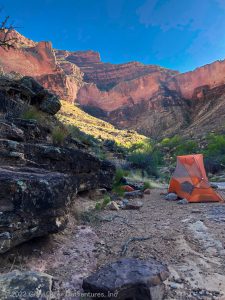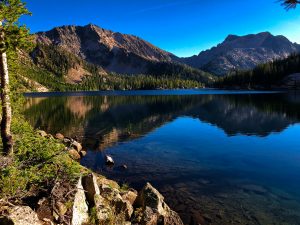
Planning your backpacking outventure is very important to a successful trip. This article examines basic considerations in backpacking planning.

Chris & Mac
We outventure to help you outventure!
Support Grey Otter Outventures!
Please help us continue to bring you great content:
Simply speaking, backpacking combines hiking and camping, carrying all you need for your trip on your back. Although a hike may be fairly simple and straight forward, backpacking increases the challenge because you will be gone anywhere from one night to, in the case of an Appalachian Trail thru-hiker, 6 months or more. Each backpack trip is different, resulting in varying technical and physical difficulties. These challenges make proper backpacking planning and preparation very important.
When planning your backpacking trip, research the trails you will hike to determine not only what you will see, but trail length, altitude, elevation gain, technical aspects of the trail, permit requirements, and camping locations:
Scenery –
There are many different types of trails. Scenery may be tree covered woods, open ridge lines, waterfalls, canyons, desert, rivers, beaches, mountains, etc. You get the point. When researching your trails, determine first whether the trail will offer the experience you seek.
Trail Lengths and Routes –
Most of us backpack because we want to see particular scenery. Most trails, however, do not have that scenery throughout the trail. Often a hiker must hike for some time before getting the “pay-off”. For example, you may have to hike several miles in a tree covered forest before reaching the scenic overlook or the waterfall you seek. Additionally, the trails may be an out and back, meaning you will see the same scenery on your return, or there may be a loop allowing you to cover new ground throughout the trip. For an out and back, you may want to consider shuttling (getting a ride to the start or leaving a car at the start and finish) so you can cover more of the trail length and will not have to return on the same route.
When you do your backpacking planning, consider whether the trail distance and daily mileage requirements are within your capability and whether you will reasonably be able to make it to the scenery you seek (remember, backpacks are heavy so you will not be able to cover the same distance you could cover on a day hike with a light pack). This can be found by reading trail descriptions, but you should also view the trail on a map. The map will give you a feel for the area and will note trail length and potential challenges such as stream crossings.
Altitude –
Knowing the starting and maximum elevation of your trip is important. During much of the year, snow and ice may be a factor on high altitude hikes, requiring special preparation and knowledge. Additionally, if you live at an altitude which is lower than that of the planned trip, your endurance and enjoyment will be affected by the elevation of the trails. A heavy pack compounds these effects, so plan your distances accordingly to ensure a fun trip.
Elevation Gain –
Elevation gain for a trip is an important number. Even if you plan to hike at a low elevation, undulations in the terrain may result in substantial elevation gain. The more the elevation gain (and loss), the more taxing the hike – particularly for older knees. Sometimes, the downs can be even harder on the knees than ups due to the pounding of consistent descent and the weight on our backs. Most trail descriptions indicate elevation gain. For an out and back (i.e., you return on the same route you hiked out), you can assume roughly the same elevation loss as the gain. For loop hikes, elevation loss may be greater or less than the gain. Researching the gain and loss will help you determine whether the trail will be fun and appropriate for your group.
Technical Aspects of the Trail –
There are a wide variety of technical challenges you may encounter on a trail. Some trails are smooth, appearing almost groomed. Most are not. Most trails have roots and rocks, but you may also encounter uneven tread, stream or snow field crossings, complete sun exposure or dense tree cover. You may even encounter the necessity of rock scrambles or hiking through scree (rock chips) on the side of the mountain which can be very taxing. You can determine the technical aspects of a trail by reading trail descriptions and comments of those who have hiked the trail. This information will help you to decide whether your experience matches the challenges of the trail, as well as the proper equipment and clothing to make the trip safe and enjoyable.
Permit Requirements –
Many backpacking areas require permits. Some permits are self-service permits, without restricted quotas, available at the trailhead or local ranger stations. Others may require you to apply in person at a ranger station or on-line and are subject to availability based on quotas. Still other areas, due to popularity, may have lottery systems for permits meaning you will have to apply to the lottery and hope you are lucky enough to get a permit when the lottery is drawn. It is essential when planning for your backpacking trip to verify whether permits are required and how to secure one.
Camping Locations –
Some areas allow “dispersed camping” (camping virtually where you want). Others issue permits for sites or specific locations to control the number of backpackers camping at the location. As part of your planning, first determine permit requirements and camping areas, then use this information together with your research on trail lengths and routes to plan your daily mileages for the trip.
Information about individual trails and where to find helpful descriptions, maps, and trail reviews can be found in our “Where to Go Backing” and “Where to Go Hiking” sections of this website.
Gear We Use for Backpacking
To see descriptions of the gear Chris & Mac use for backpacking, as well as links to manufacturers and retailers offering the gear for sale, please CLICK HERE.
SAFETY DISCLAIMER: The activities discussed in this website are outdoor activities and, as such, have inherent risks to which participants are exposed. It is not the intent of this website, nor is it possible due to the variability of weather, terrain, equipment, and experience, to detail all of those risks. The information contained in this site is informational, but not instructive nor exhaustive. It is the sole responsibility of the user to ensure he/she is in good health, fully prepared, and fully informed as to dangers before undertaking any of the activities discussed in this website and the user does so at his/her own risk. The user understands that by using this website he/she acknowledges and accepts all risks associated with use of information from this website and participation in any particular activity addressed herein. Please see “Terms of Use” for additional information.
Want to share this article with your friends? Click on the share button below:
Want more?
Get the latest outventure updates by following us on social media . . .


